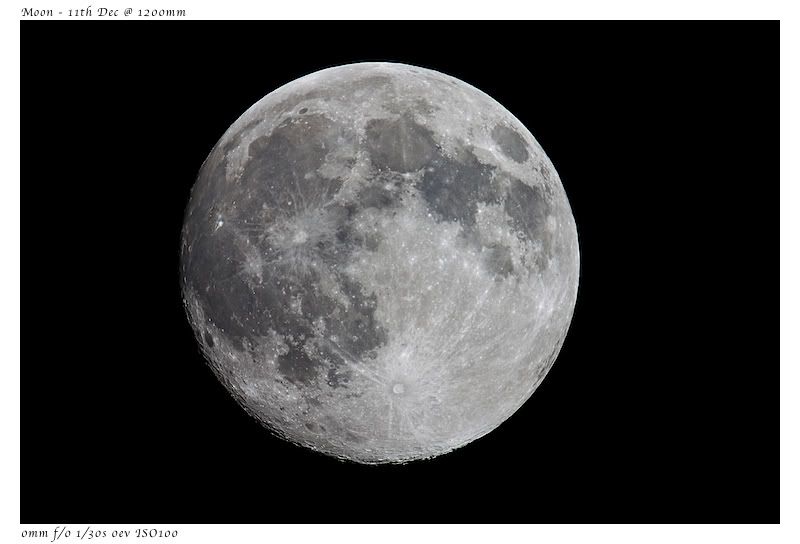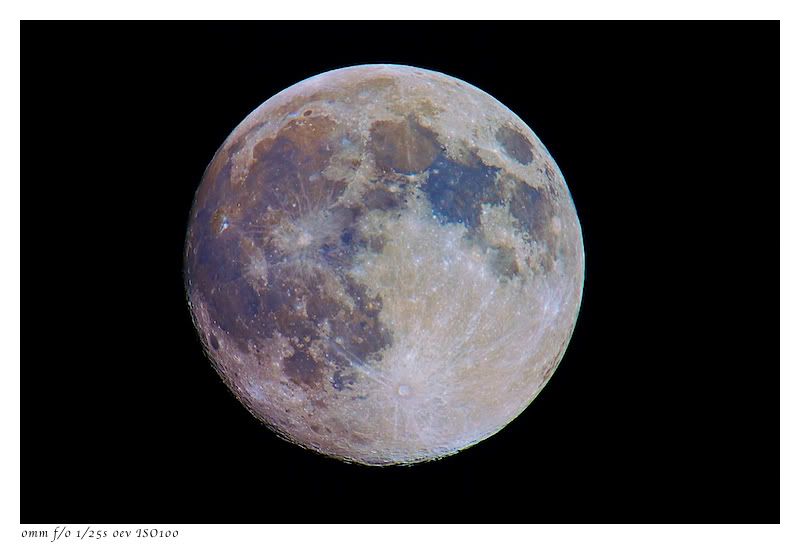Despite the cloud that kept drifting through early evening, threatening to spoil the night completely. At about 9pm, it was thin enough, and the moon bright enough, I decided to set up and have a look see anyway. After the usual, level, and power up, I aligned on the moon, this time taking more care to be as precise as could be, not easy with a 5mm ortho, on getting the centre aligned. Then I popped in the 5mm Hyperion with twin tuning rings (making 2.5mm) and started having a look around. With the cloud, the conditions weren't good enough for that much power (x240), so I removed the 14mm tuning ring making it a 3.5mm ep (x172) and used that instead. Firstly, as I slewed across the surface, I was again astonished by the amount of texture that the view provided. The fully lit main section of the moon was showing in an almost 3d way, with the rays from Tycho looking almost like deep troughs across the surface. I drifted across the terminator and pondered the mountains whose peaks were just showing in the light, an eerie and amazing sight. Then started looking properly with the "New Atlas of the Moon" out.
I started at Aristarchus, it's amazing how bright this crater is compared to the surrounding area. Then found Prinz. I'd forgotten about the oddities of direction induced using a refractor and diagonal, and using the map for a reflector and kept moving in the wrong direction. Ah well, that soon passed. Then I found Reiner and Reiner gamma and onto Cavalerius. This of course led neatly into Hevelius and Grimaldi. I recall when I first found Grimaldi, how much difficulty I had making it out with the Vista, no problems at all last night with the ED80. Clear and sharp. Gassendi was clear and easy to find and I found Sirsalis too. Then, to be honest, I got fed up with keep taking my eye away from the ep to check in the atlas and make notes, there'll be plenty of time for that, and just meandered my way around, in amongst the craters, seas, mountains and oceans admiring the crispness of the view.
I then grabbed the 450d, bolted on the OM adapter and OM 2xTC and nose piece and shot a few of the moon at 1200mm. It was a little tricky getting the settings right as the thin cloud was causing changing light, but I got it.
After finishing I had a go at a colouring of the moon, to pull out the natural surface colours
I then set the camera to take 10 shots on it's self timer and took a bunch of them in jpg to attempt to stack. I haven't had a chance to do this as yet, but I'll post the results as soon as I have.
I then decide to do a little more analytical testing to find out what this scope was really like on the stars. I slewed to Betelguese, just showing over the roof, keeping the 5mm Hyperion (at 3.5mm) and popped the star inside and outside of focus. The rings looked spot on both sides of focus, and the colour of Betelguese was really vivid with the crisp and sharp view.
I tried to get a look at a couple of clusters, but the clouds and the moon were having none of it, but the views through the 17 and 24 mm Hyperions were equally as impressive. However, Castor and Pollux were visible so I decided to test the scope on Castor, as it's a double star, and using the 5mm+tr, I could clearly make out the secondary and a most definite gap between them, both stars being pinpoints of light.
I then slewed around to have a look at M42, but this was not to be, I'd been spotted again by the cloud pixies and within moments of pointing the scope in the right direction, was clouded out.
I used the 6x30 finder scope, and whilst it will take a little getting used to, and is slightly harder to use than an RDF, it's very clear views, and erect image optics make it a useful tool.
Thursday, 11 December 2008
C80ED, second light.
Subscribe to:
Post Comments (Atom)







2 comments:
Just a random comment to say I'm enjoying reading the blog; compensating nicely for cloudy nights or nights stuck in the office.
Lovely images John. Just getting into the Lunar 100 myself. The C80ED certainly does a first class job.
Post a Comment